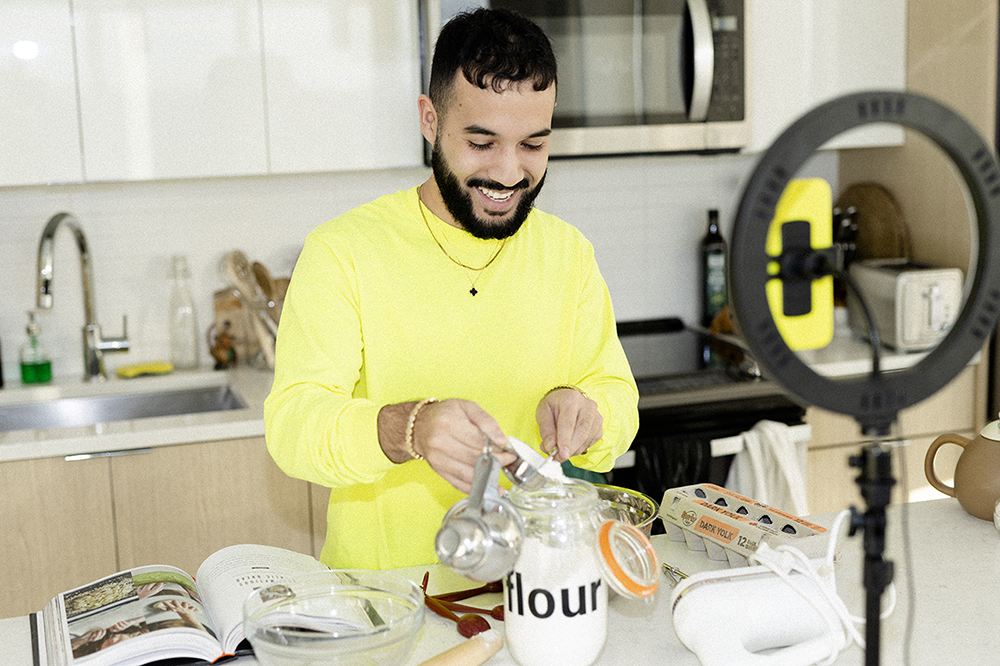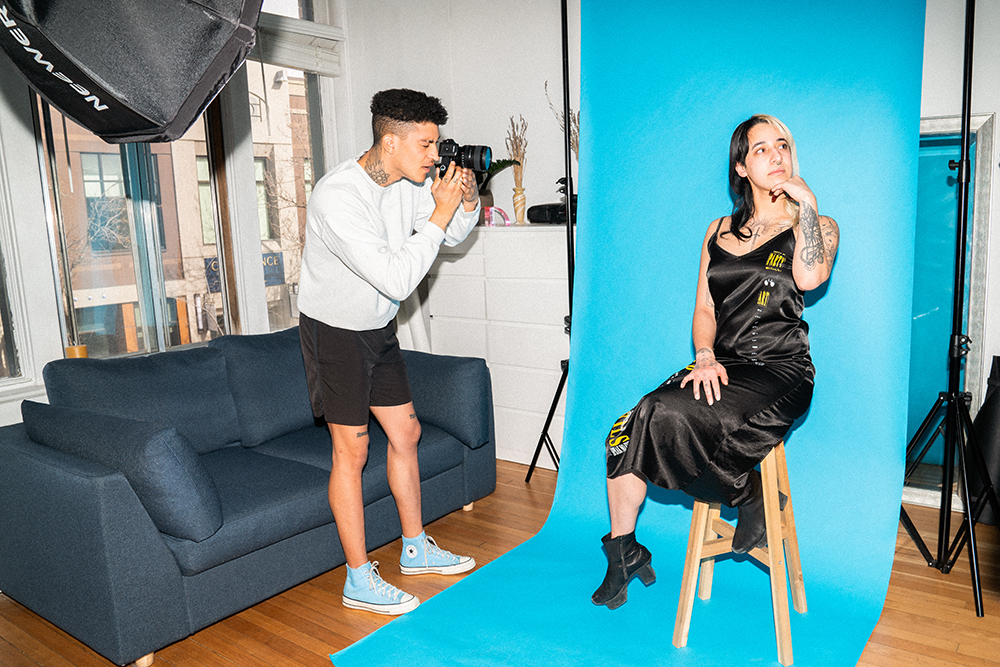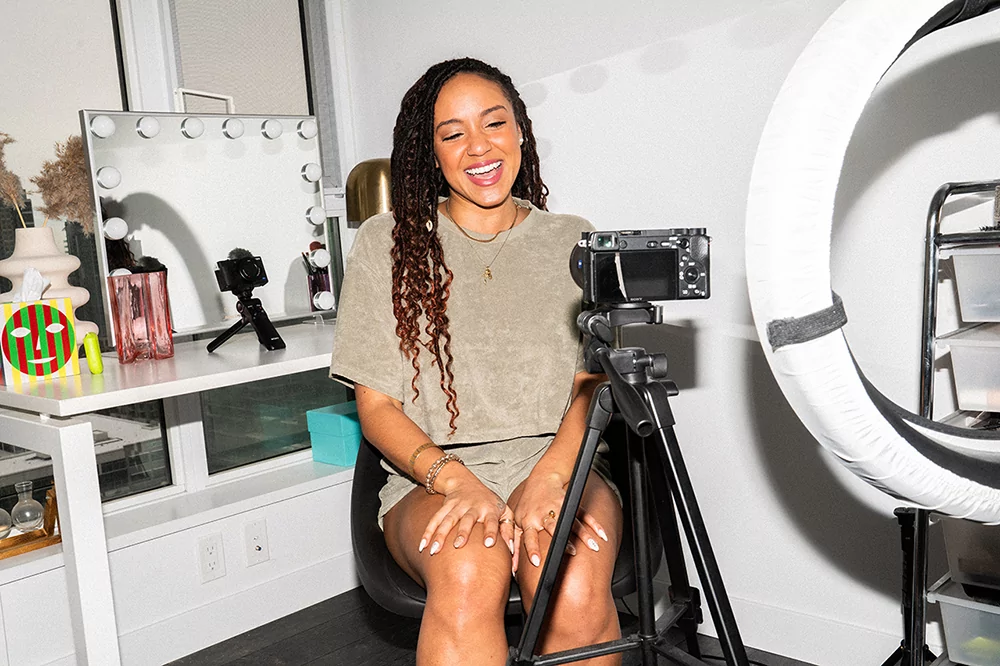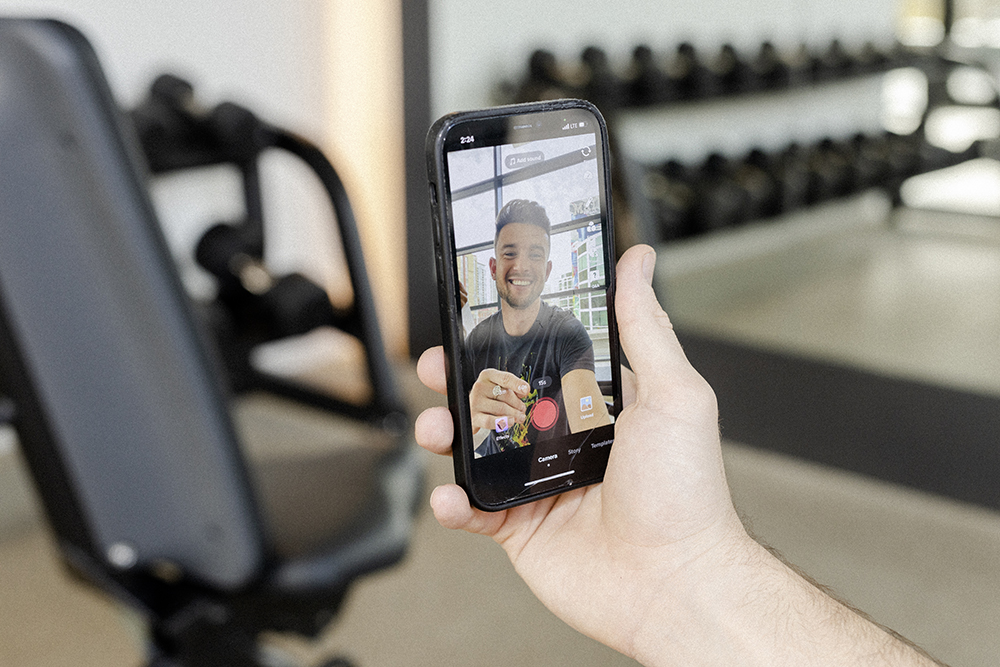A decade ago, who would have known that anyone could earn six figures from talking to the camera and making simple gestures in one-minute video clips? And from the comfort of their own home, too? Fast forward to 2023: Khaby Lame has built one of the most successful content creator careers by making comedic TikTok videos. And he isn’t the only one. Over 50 million people worldwide consider themselves creators, with many of them earning money by sharing unique content that educates and entertains their audiences.
So, maybe you just watched your favorite creator’s latest TikTok video and have asked yourself, “Can I do this too?” The answer is: yes, you can.
You don’t necessarily need special skills or training to become a successful content creator. If you can consistently produce content, and share your ideas in a fun and engaging way, you will succeed and may even become many people’s favorite creator, too!
This article is your all-inclusive guide on how to become a content creator. There’s no magic here — just tried-and-true tips that will transform you from content newbie to pro creator.
What is a content creator?

A content creator is someone who creates content consistently. Think videos, photos, digital art, blog posts, ebooks, or even Twitter threads.
You don’t need any special qualifications to become a content creator or to start creating content. But you must commit to posting content regularly in order to build an audience, become an authority in your niche, and ultimately, earn money.
Related: Everything you need to know about the creator economy
What are different types of content creators?

Just as there are numerous content formats and various platforms, there are also many different types of creators. This means that, as an aspiring content creator, you have a lot of options!
On your way to becoming a content creator, don’t try to put yourself into a box. Instead, play to your strengths and choose content formats and digital platforms that can help you reach the right audience.
1. Influencer
During a press conference in 2021, Portuguese footballer, Cristiano Ronaldo, removed two Coca-Cola bottles from his table, requesting water instead. That single move wiped $4 billion from Coca-Cola’s stock market value. Such is the power of an influencer!
An influencer is someone who has built some degree of credibility in their niche due to their unique talent or insight. They usually have a decent and devoted social media following — people who know, like, and trust their brand — and can sway their followers’ decisions. Companies that want to market their products or services to an influencer’s community engages them through partnerships and sponsorships.
Social media influencers are also platform-agnostic, meaning they create content across multiple channels simultaneously. Most social media influencers start with one platform and move to others once they get a solid footing.
Related: How to become a social media influencer and make money
2. Blogger
If you have great research chops and decent writing skills, you can be a blogger or content writer. Bloggers write and publish articles, either on their own website, other blogs, or on third-party publishing platforms like Medium.
There are many ways to monetize blogging. If you publish content on your website, you can make money from paid ad placements. In other words, people pay to advertise their products and services on your website.
Companies and other creators in your niche can also pay you to write a blog post (or many!) for their own website. You can start a paid newsletter column on platforms like Substack.
Related: How to start a blog
3. Podcaster
Out with radio shows; in with podcasts. As a podcaster, you get to share your thoughts and opinions on trending topics — red carpet style at the Grammys, pop culture news, or less-glamorous issues like economic downturns and recessions — with your audience via the spoken word.
You don’t need any radio hosting experience to run a podcast. In fact, most of the time, listeners aren’t looking for that. Podcast audiences usually want you to share your knowledge and experience from an interesting and authentic point of view. In other words, they want to know what you think.
It doesn’t cost much to set up a podcast. You can record and edit podcast episodes on your smartphone with apps like Riverside and Descript. Once it’s all set, you can publish the podcast on Spotify, SoundCloud, Apple Podcasts, and other audio hosting sites.
As your podcast gains traction, you can start earning from paid promotions and sponsorships.
4. Vlogger
Chances are you’ve come across “get ready with me” or “a day in my life” videos on YouTube These are great examples of vlogs.
A vlogger — or video blogger — creates videos and shares them on platforms like YouTube, Twitch, and TikTok. Most of these videos are about the creator’s personal experiences, like their travels, their new purchases, or their career journeys.
Vlogging certainly requires some work, but it’s something you can pull off with a little bit of effort. First, you need to learn how to record great videos. Your audience doesn’t expect cinema-quality vlogs, but your videos must check three boxes:
- Good lighting
- Clear audio
- Good camera angles
After recording your video content, it’s time to edit it so it’s ready for your audience’s viewing pleasure. Add background music, insert a cover image, remove unnecessary clips, and add a watermark if you like. You might also need to make adjustments based on the content guidelines and specifications of your vlogging platform.
When it’s all set, upload your vlog and share the link with your audience to drive traffic to the vlog.
Related: How to create a YouTube video
5. Photographers and Videographers
Photos and videos are literally the currency of social media, so there are a ton of opportunities for anyone skilled in these areas.
As a photographer or videographer, you can make money by sharing your work on social media platforms like Instagram and YouTube. Once you have a decent amount of followers and a good engagement rate, you can snag cool brand deals, or even earn cash through a social media platform’s creator program.
If you’re not a fan of personal branding or being a social media influencer, you can help other creators publish professional content on their pages for a fee. Or you might go the freelance content creator route and sell these visual assets to stock image and licensing platforms.
7 Steps to become a successful content creator
After you’ve determined what type of creator you’d like to become, it’s time to get to work. Here are seven steps that will help you get started as a content creator.
Step 1: Figure out your creator personality

Figuring out your creator personality is the most important thing you’ll do as you’re starting out. This step will provide clarity for the subsequent decisions you’ll make and the steps you’ll take in your creator journey — from the audience you’ll target, to the type of content you create and even the platform you choose.
Generally, there are two types of creator personalities to choose from: creator educator and creator entertainer.
In a nutshell, creator educators teach while creator entertainers delight and amuse. You can probably split your favorite creators into these two categories. For example, Miss Excel and Erika Kullberg are creator educators. On the other hand, TonyTalks and Brian Moller are creator entertainers.
All of these creators are successful in their own right, which tells you one thing: no category is better than the other. Your focus, therefore, should be choosing the creator personality that aligns with your values and allows you to express yourself freely.
Let your “why” guide you. Think deeply about why you want to be a creator. What’s the one thing you want to achieve and be known for? If your goal is to make people happy and help them cope with stress, entertainment is the way to go. And if you want to share knowledge and help improve your followers’ lives, you might be an educator at heart.
Related: Why creator educators are making bank
Step 2: Choose a niche

What would you say if someone asked you to describe Marques Brownlee in two words? Probably “tech creator.”
Brownlee has built a solid brand by sharing video reviews of different tech gadgets, from iPhones and MacBooks to video games and cameras. In other words, he has found his niche, and his creator career is better for it.
As a first-time creator, it’s tempting to post random content spontaneously, but this is a one-way ticket to slow progress and burnout. So, you need to find your niche: a topic or area you’re genuinely passionate about.
Your niche can be anything, from tech to fitness and even astrology. The more specific it is, the more likely your content will stand out and capture your audience’s attention. There’s a huge difference between a generic finance creator and a finance creator who shares simple, money-saving tips for millennials and Gen Z.
Also, feel free to explore beyond the conventional topics. You’d be surprised by just how many people share your interests. Like, who knew that learning about Microsoft Excel could be fun until Miss Excel came along?
Once you’ve nailed your niche, brainstorming content ideas, gaining traction from your target audience, and creating content consistently all become a breeze.
Related: How to find your niche in four simple steps
Step 3: Develop your style and personal brand

Your style is what makes your content unique. Think of it as your trademark. Your style could include the particular background music you use, the way you edit images, or the tagline you use to sign off your blog posts. All these elements of style come together to create your personal brand.
Once you’ve nailed a style and have fine-tuned your personal brand, you’ll be sure to stand out in a sea of content creators. Many successful content creators prove this point. For example, Khaby Lame quickly became an A-list TikToker thanks to his unique style of humorous silent videos.
The hack for finding your style? Be yourself! Other creators’ styles can inspire you, but don’t copy them blatantly. Find something that truly resonates with your personality and let it shine through in your content.
And, remember, style can be anything. Don’t force humor or sarcasm if it doesn’t come naturally to you. Do what you’re comfortable with and you’ll find your audience quickly.
Step 4: Choose a platform

Your platform is the primary place where you’ll publish your content. It’s also where you’ll connect with your target audience and, hopefully, start building a community. From Instagram to TikTok to YouTube, there are many different platforms to choose from.
When wading through the options, two things should guide your choice of platform: target audience and content format.
1. Target audience
Publish content where your target audience hangs out. This is the fastest and easiest way to get your brand in front of them.
For example, if you’re targeting Gen Z, then YouTube, Instagram, and TikTok are the best platforms because these are the places they hang out most. If millennials are your specific audience, then Facebook is one of the best places to reach them.
2. Content format
Make sure that you choose a platform that supports your preferred content format. If you’re creating long-form video content, then YouTube should be your platform of choice. On the other hand, if you’re a photographer, then a visual content platform like Instagram is likely the best place to showcase your work.
Step 5: Develop a content calendar
Most new content creators struggle with consistency. At first, beginners are super excited to create content and publish it. After a few days, however, that excitement can dwindle and they might stop showing up altogether. In this case, a lack of passion isn’t necessarily the issue. Rather, these newbies may have failed to hatch a consistency plan: a schedule for creating and publishing content regularly.
A content calendar helps you plan your content creation and publishing cadence so you keep putting out content — even when you’re not motivated to do so. This way, you build trust with your community.
Creating a content calendar is easy. You only have to account for three things:
- Content creation days
- Content publishing days
- Content formats
Here’s a simple content calendar for a YouTube content creator who puts out a new video every week.
Saturday
- Shoot a new video (15 minutes long).
Monday
- Edit video.
Tuesday
- Post video snippet on Instagram and ask followers to subscribe to their YouTube channel.
Wednesday
- Post video on YouTube.
- Share a 1-minute clip on TikTok.
Friday
- Promote the video on Twitter.
Make sure your plan is realistic so you can consistently produce quality content and grow as a creator. As time passes, you will update your calendar based on content performance and feedback from your audience.
Step 6: Get the right content creation tools

Creating quality content is easy when you have the right tools. Say you’re a video creator. You’ll need a good camera, great lighting, and a decent background to create eye-catching video content.
On the other hand, if you’re a blogger, you’ll want to invest in search engine optimization tools like Semrush to improve the chances of your web content ranking high on Google to drive organic traffic to your website.
We suggest you don’t spend too much money on creation tools in your early days as a content creator. Look for affordable tools that help you create decent content first. Use your smartphone to shoot videos instead of buying a professional-level camera. Publish written content on free sites like Susbtack and Medium instead of paying for web hosting. In other words, start small.
As your content creator career flourishes, you can invest in better tools and create content of higher quality. But don’t ever let a lack of tools keep you from sharing your work!
Step 7: Track performance metrics

Tracking content performance lets you know what’s working and what needs improvement — after all, you can’t improve what you don’t measure.
Tracking also reveals important information about your audience’s behavior, like which times they are online and the types of content they like. Using this information, you’ll be able to refine your content creation and publishing processes most effectively.
So what metrics should you track? It depends on the social platforms you’re using. If you’re an Instagram content creator, you should be looking at metrics like shares, follower growth, and impressions. If you’re a TikTok creator, you can track your weekly views, monthly follower growth rate, and total views over a specific period.
You will thrive as a content creator if you base your decisions on hard data.
How much money can content creators make?

Kylie Jenner reportedly makes $1,835,000 on average per sponsored post. Just in case you’re about to roll your eyes and say, “But she’s a celebrity,” here’s another piece of data: YouTube star MrBeast made a whopping $54 million in 2021.
Are these outliers, or do social media content creators actually make that much money? Let’s take a look at the numbers.
- In 2022, the average YouTuber in the U.S. earned $4,616 per month — that’s about $55,000 per year. Not bad!
- Zip Recruiter places the average salary of a U.S. content creator at $50,510 a year.
- A Hype Auditor survey found that Instagram micro-influencers (less than 10,000 followers) earn $2,970 monthly.
- Big Instagram influencers (with over 1 million followers) earn $15,356 per month.
- TikTok influencers with up to 100,000 followers earn an average of $793 per post.
- Twitter influencers who have less than 5,000 followers charge $56 per post. While those with more than 25,000 followers earn an average of $126 per post.
Not every content creator will earn millions of dollars — and that’s okay. But, one thing’s for sure: you can make a decent amount of money from content creation, and the numbers above prove it.
Try content creation as a side hustle first

Being a creator is a rewarding experience. You get the chance to build a community that trusts you. You can experiment with content creation, and create content in different formats and on multiple platforms. And you can work with brands you like and on projects you enjoy. That’s a lot of fun and freedom!
While being a full-time content creator has a plethora of upsides, it isn’t all roses and sunshine. As a creator, you could face dry spells, tough clients and online trolls, and creative blocks at different times. You must prepare for these challenges, and the best way to do that is to try content creation as a side hustle first before fully diving in.
Think of this phase as a paid internship where you get to learn the ropes while having the safety net of a regular job. Once you’ve found your rhythm as a moonlighting creator, you can quit your day job and go all in!
So, now that you’ve learned how to become a content creator, all you need to do is begin.
Need help starting your content empire? Sign up for The Leap’s Creator Starter Bundle for free courses and workshops taught by experienced creators!
@the.leap We’re spilling the tea! We’ve released a FREE creator starter bundle 👀 Get access to workshops, mini courses and more resources for creators — all for free! Check out the link in our bio! #creatoreconomy #freecreatorresource #igcreator #tiktokcreator #creatorinfo #greenscreen
♬ Renaissance (Main Title Theme) [from “The White Lotus: Season 2”] – Cristobal Tapia De Veer
FAQ
We’ve answered some of the top questions from newbie content creators.
What qualifications do you need to be a content creator?
You don’t need any special qualifications to get started as a creator. However, if you’re a creator educator, you’ll need to have some sort of subject matter expertise, especially for more complex and sensitive topics. This way, you’ll build trust with your audience by providing them with correct and verifiable information.
How much money do content creators make?
The average content creator earns about $44,000 per year. This depends on factors like location, experience, and sometimes the type of content they create. More famous creators like Kylie Jenner earn millions of dollars every year.
Can I be a content creator with no experience?
Yes! You do not need any prior experience to become a content creator. You can be a successful creator if you have a unique idea and knowledge to share with the world.
Is it easy to become a content creator?
No. Like any other job, content creation has its challenges. To succeed as a creator, you need to learn how to create and distribute content, build your personal brand, and deliver quality content consistently.
Follow The Leap on TikTok and Instagram for more content creation tips. We also make a newsletter.

